Monday, February 28, 2011
Kimber on the truck
Well, I finally got a chance to get the Kimber over to a UPS service center for shipment so it's on its way back to see if they can get it working. 4-6 week wait, minimum. We'll see what happens.
Sunday, February 27, 2011
Kimber Super Carry Pro
How Super is the Super Carry Pro?
The Kimber Super Carry Pro is one of Kimber's newest pistols. Since I like carrying a 1911, its combination of features was hard to pass up once I saw and handled it in person at one of my local gunshops. Despite the hit or miss reputation of Kimber in online reviews, I decided I would take a chance on my first Kimber and bought one of the first Super Carry Pros available locally several months back.
Intended for concealed carry, one of its most notable features is the rounded heel and mainspring housing. This makes the grip less likely to "print," or show through, your concealing garment than the same size pistol with a more traditional grip. Other features on the Super Carry Pro that can be beneficial on a carry pistol are the flush fit 8 round magazine (one included), serrated frontstrap and MSH, ambidextrous extended thumb safeties, 3-dot tritium night sights with a cocking shoulder for one-handed use, "carry melt" treatment to smooth sharp edges, aggressively checkered grips, loaded chamber indicator port in the top of the slide, and lightweight aluminum frame.
The lightweight government frame of the SCP is made from 7075-T7 aluminum and has a satin silver "KimPro II" finish. It is nicely machined and as mentioned, lightweight compared to a steel frame. The magwell is beveled for easier magazine insertion and the trigger guard has a high cut to help you take a higher grip. The grip safety is a high rise beavertail style, and while the fit is good, it could be a bit better for a pistol in this price range. The MSH fit was better.
Since this pistol does not use a ramped barrel, the feed ramp is also aluminum. This is worth mentioning because after the 850 rounds I have fired through this pistol, there are visible wear marks on the ramp. My steel framed 1911s do not show anywhere close to the same degree of wear with similar or higher round counts. A ramped barrel would also have prevented the problem.
The slide is stainless steel with a matte black "KimPro II" finish that Kimber says is self-lubricating. The benefit of that seems unclear because you still need to lubricate the moving parts. It has a flat top cut and "Super Carry" pattern serrations both across the top and on the rear sides. The ejection port is lowered and flared, and ejection was not an issue. This pistol does not use the "Kimber Firing Pin Safety" so commonly used in the Kimber lineup. Since you still have the grip and thumb safeties, this is not an issue.
The "match grade" trigger is a solid aluminum piece. Trigger pull weight felt a bit high though, even without the extra safety, and I'm not sure I'd call it "match grade". It's not a deal breaker, but it is heavier and less smooth than the factory STI triggers, for example. The Colt Combat Elite factory trigger also has a better feel to me. Trigger feel is subjective and may vary from pistol to pistol, so your experience may differ. For the record, Kimber states it comes from the factory set at 4-5 lbs. I do not have a trigger gauge so I couldn't verify that on my pistol.
The barrel is a bushingless, single piece, 4" long, "match grade" part with a polished breech face. Kimber states it also has a "match chamber" for what that's worth. I don't know what criteria they use to designate it as match quality, but my example does exhibit very good accuracy in informal off hand practice at the range. It is up there with the more accurate pistols I have shot. I don't shoot from a pistol rest, don't shoot pistols for measured group size, and don't practice beyond 15 yards with a pistol much, so I can't speak to those areas. What can I say, I favor rifles for those tasks and I don't write reviews for a living.
The finish has held up very well in range use, and despite the 850 rounds through it, the area around the ejection port has also held up well. I have not been able to test the finish in carry usage or for holster wear due to reliability issues that do not give me the confidence to carry this pistol.
That brings me to reliability. Before I even bought this pistol, I knew Kimber said their pistols needed a 500 round "break-in period." That was the main reason I had never bought a Kimber before the Super Carry Pro. I am one of those that feels you should function test a pistol with at least a couple hundred rounds of FMJ and at least 50 rounds of your carry ammo with zero problems before you carry it, but you shouldn't [I]need[/I] a "break-in period" for reliable function on a pistol designed for carry use. Since "Carry" is in the name, that's how I feel about the Super Carry Pro.
I took a 250 round box of FMJ 230gr PMC to the range and proceeded to run it through my SCP. I wound up with an average of about 1 malfunction per magazine, typically a failure to feed the next round all the way into the chamber. That means that with 8 round mags, I had about 25-30 failures, or only about 88-90% reliability.
Okay, I figured, I am a little concerned but I am only halfway through the "break-in period." I ran another 250 rounds of FMJ from various brands and had the same pattern of failures, but it improved to about 90-95% reliability. At this point I had run 500 rounds, and I was starting not to like this pistol.
For my third range trip, I switched to JHP ammo from Winchester, Hornady and Speer. I also switched from my usual oil lubricant to a grease to see if that would help. I ran about 150 rounds of 230gr JHP through, and it seemed to run about 97% with four failures. I switched back to FMJ and ran another 100 through, with four failures.
The total round count was up to 750, with about 94% reliability (somewhere close to 50 failures all together). I was starting to HATE this pistol now. The only other time I've had such an unreliable pistol is when I took a chance on the Diamondback DB380 when it first came out.
Back home, I stripped the pistol down and gave it a good cleaning, and switched back to an oil lubricant. I also replaced the factory spring with a Wolff spring for 4" Kimbers and headed back to the range. I took another 250 round box of 230gr FMJ, and proceeded to run the first hundred through the Kimber. I had two failures, with one in the first 50 rounds and one in the second. Okay, that's it, the best I could get in a single range trip was 98% reliability. Not wanting to let a range trip go to waste, I stayed around a fired the rest of the ammo through my STI Shadow and Colt Combat Elite with nary a problem.
If a freshly cleaned and lubricated pistol with a new spring can't manage to make it through 100 rounds problem free, I am not wasting any more ammo on it. Nothing appears to be wrong with the extractor, ejector, etc. No burrs on either the slide or frame. Not a magazine problem*. That leaves me having to try giving Kimber a call and see if they can fix it. Even if they do, I won't ever have confidence in this pistol and will probably sell or trade it. I have two Colts and four STIs, and none of the six needed a "break-in period" or had reliability problems. It's not the "tightness" of the Kimber assembly either, as my STIs are all at least as tight if not tighter than the Kimber.
Would I recommend this pistol? It's probably obvious by now, but I have to say no based on my sample. The Super Carry Pro turned out to be Super Frustrating. For the price, it should exhibit a little better fitting, have a more durable feed ramp or a ramped barrel, and should not have the reliability issues that mine has. However, if those issues were solved or are not an issue on your example, I would say it would make a very good carry pistol. It conceals well, shoots very well, and could be a great carry pistol if Kimber put enough QC/QA into it.
*All shooting was done using the factory KimPro Tac-mag, Wilson magazines, and some Colt factory magazines. The only time I could discern a specific magazine didn't work well with the SCP was with the Colt magazines. They work in my other pistols but showed the most failures to feed in the SCP. The failures showed up randomly enough with both the KimPro and Wilson magazines that I do not attribute any failures specifically to those magazines. I mentioned the fit of the grip safety earlier, and it may have contributed to the tendency of this pistol to leave a wide "v" shaped blood blister in the web between my thumb and forefinger when shooting a lot of rounds. I don't have any other pistols that do that.
Note: After I wrote this review, I called Kimber and this pistol is being sent back to Kimber to see if they can fix it.
Kimber Super Carry Pro
Caliber: .45ACP
Frame: 7075-T7 aluminum
government length
"Super Carry" pattern serrations on frontstrap and mainspring housing
high cut trigger guard
beveled magwell
rounded heel
Slide: stainless steel
flat top style
"Super Carry" pattern top and rear cocking serrations
oversized ejection port
enlarged firing pin stop to lock extractor in place
Barrel: 4" bushingless, single piece, non-ramped
LH 1:16 twist
loaded chamber indicator port in the top
polished breech face
Mainspring Housing: rounded with "Super Carry" pattern serrations
External Safety: ambidextrous extended thumb safety
Grip Safety: high rise beavertail
Sights: Tritium three dot night sights with cocking shoulder
Guide rod: full length
Hammer: commander style
Grips: micarta/laminated wood fully checkered with border
Capacity: 8 + 1
Magazine: KimPro stainless steel Tac-Mag
Teflon coated stainless steel follower
quick change floor plate (only the flat stainless steel floor plate included)
one included with purchase
Other: "match grade" chamber, barrel, and trigger (solid aluminum style)
lowered and flared ejection port
recessed slide stop pin with beveled surround in the frame
"carry melt" treatment
22lb recoil spring, manual recommends changing every 800 rounds
checkered, slightly extended magazine release
does not have the "Kimber firing pin safety"
manual states there is a 400-500 round "break-in period"
Finish: KimPro II "self lubricating"
matte black slide
satin silver frame
Length: 7.7"
Height: 5.25"
Weight: 28 ounces
Website: http://kimberamerica.com
MSRP: $1,530 (as of Feb. 2011)
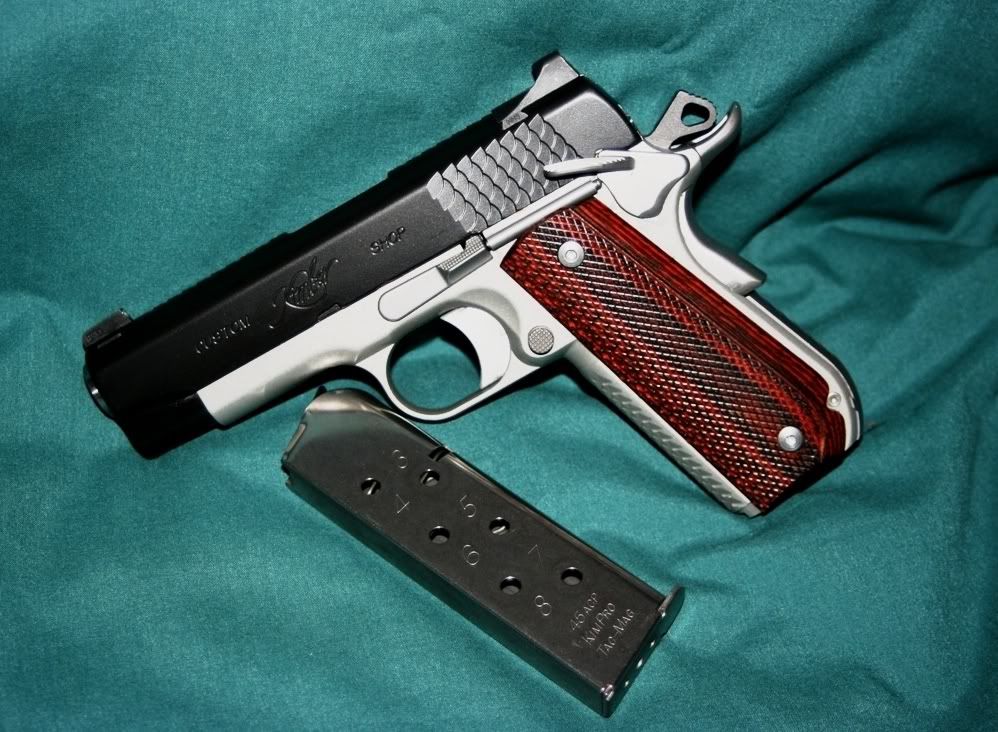


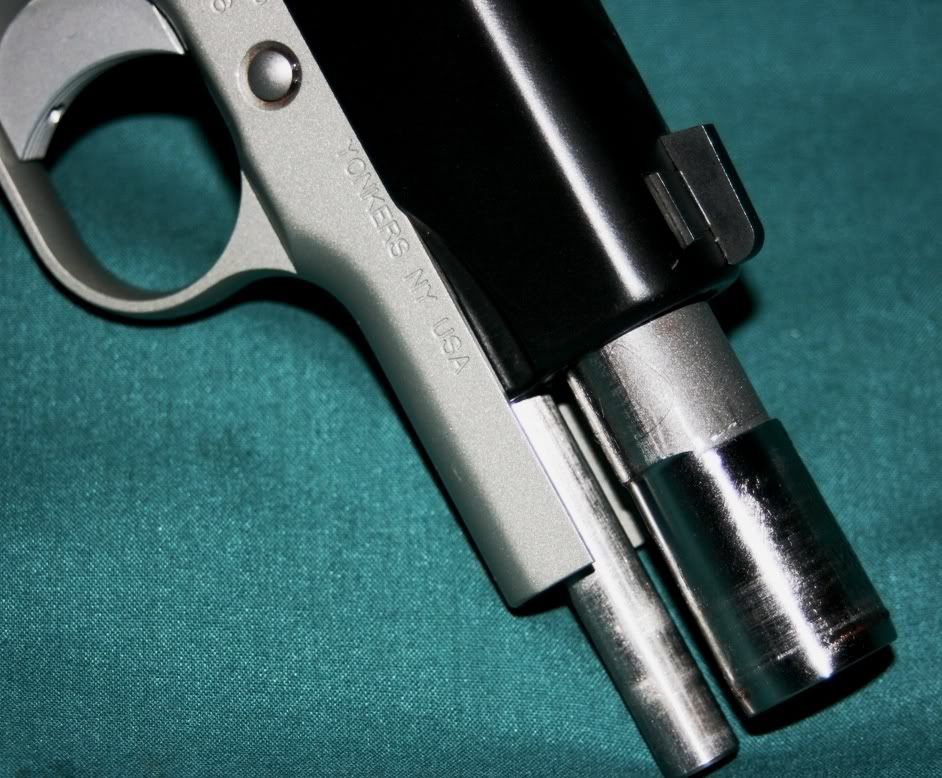
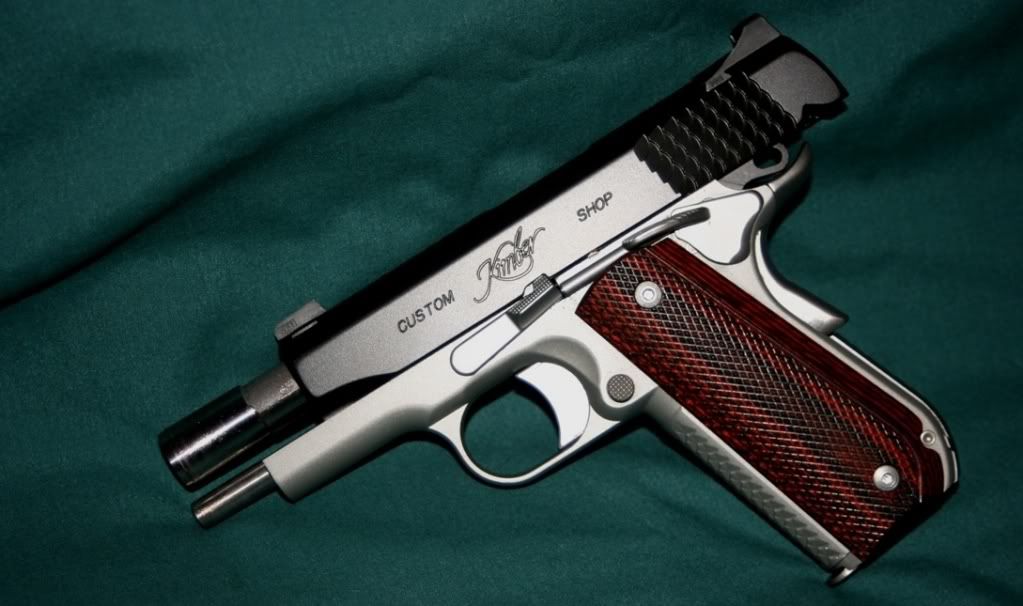



The Kimber Super Carry Pro is one of Kimber's newest pistols. Since I like carrying a 1911, its combination of features was hard to pass up once I saw and handled it in person at one of my local gunshops. Despite the hit or miss reputation of Kimber in online reviews, I decided I would take a chance on my first Kimber and bought one of the first Super Carry Pros available locally several months back.
Intended for concealed carry, one of its most notable features is the rounded heel and mainspring housing. This makes the grip less likely to "print," or show through, your concealing garment than the same size pistol with a more traditional grip. Other features on the Super Carry Pro that can be beneficial on a carry pistol are the flush fit 8 round magazine (one included), serrated frontstrap and MSH, ambidextrous extended thumb safeties, 3-dot tritium night sights with a cocking shoulder for one-handed use, "carry melt" treatment to smooth sharp edges, aggressively checkered grips, loaded chamber indicator port in the top of the slide, and lightweight aluminum frame.
The lightweight government frame of the SCP is made from 7075-T7 aluminum and has a satin silver "KimPro II" finish. It is nicely machined and as mentioned, lightweight compared to a steel frame. The magwell is beveled for easier magazine insertion and the trigger guard has a high cut to help you take a higher grip. The grip safety is a high rise beavertail style, and while the fit is good, it could be a bit better for a pistol in this price range. The MSH fit was better.
Since this pistol does not use a ramped barrel, the feed ramp is also aluminum. This is worth mentioning because after the 850 rounds I have fired through this pistol, there are visible wear marks on the ramp. My steel framed 1911s do not show anywhere close to the same degree of wear with similar or higher round counts. A ramped barrel would also have prevented the problem.
The slide is stainless steel with a matte black "KimPro II" finish that Kimber says is self-lubricating. The benefit of that seems unclear because you still need to lubricate the moving parts. It has a flat top cut and "Super Carry" pattern serrations both across the top and on the rear sides. The ejection port is lowered and flared, and ejection was not an issue. This pistol does not use the "Kimber Firing Pin Safety" so commonly used in the Kimber lineup. Since you still have the grip and thumb safeties, this is not an issue.
The "match grade" trigger is a solid aluminum piece. Trigger pull weight felt a bit high though, even without the extra safety, and I'm not sure I'd call it "match grade". It's not a deal breaker, but it is heavier and less smooth than the factory STI triggers, for example. The Colt Combat Elite factory trigger also has a better feel to me. Trigger feel is subjective and may vary from pistol to pistol, so your experience may differ. For the record, Kimber states it comes from the factory set at 4-5 lbs. I do not have a trigger gauge so I couldn't verify that on my pistol.
The barrel is a bushingless, single piece, 4" long, "match grade" part with a polished breech face. Kimber states it also has a "match chamber" for what that's worth. I don't know what criteria they use to designate it as match quality, but my example does exhibit very good accuracy in informal off hand practice at the range. It is up there with the more accurate pistols I have shot. I don't shoot from a pistol rest, don't shoot pistols for measured group size, and don't practice beyond 15 yards with a pistol much, so I can't speak to those areas. What can I say, I favor rifles for those tasks and I don't write reviews for a living.
The finish has held up very well in range use, and despite the 850 rounds through it, the area around the ejection port has also held up well. I have not been able to test the finish in carry usage or for holster wear due to reliability issues that do not give me the confidence to carry this pistol.
That brings me to reliability. Before I even bought this pistol, I knew Kimber said their pistols needed a 500 round "break-in period." That was the main reason I had never bought a Kimber before the Super Carry Pro. I am one of those that feels you should function test a pistol with at least a couple hundred rounds of FMJ and at least 50 rounds of your carry ammo with zero problems before you carry it, but you shouldn't [I]need[/I] a "break-in period" for reliable function on a pistol designed for carry use. Since "Carry" is in the name, that's how I feel about the Super Carry Pro.
I took a 250 round box of FMJ 230gr PMC to the range and proceeded to run it through my SCP. I wound up with an average of about 1 malfunction per magazine, typically a failure to feed the next round all the way into the chamber. That means that with 8 round mags, I had about 25-30 failures, or only about 88-90% reliability.
Okay, I figured, I am a little concerned but I am only halfway through the "break-in period." I ran another 250 rounds of FMJ from various brands and had the same pattern of failures, but it improved to about 90-95% reliability. At this point I had run 500 rounds, and I was starting not to like this pistol.
For my third range trip, I switched to JHP ammo from Winchester, Hornady and Speer. I also switched from my usual oil lubricant to a grease to see if that would help. I ran about 150 rounds of 230gr JHP through, and it seemed to run about 97% with four failures. I switched back to FMJ and ran another 100 through, with four failures.
The total round count was up to 750, with about 94% reliability (somewhere close to 50 failures all together). I was starting to HATE this pistol now. The only other time I've had such an unreliable pistol is when I took a chance on the Diamondback DB380 when it first came out.
Back home, I stripped the pistol down and gave it a good cleaning, and switched back to an oil lubricant. I also replaced the factory spring with a Wolff spring for 4" Kimbers and headed back to the range. I took another 250 round box of 230gr FMJ, and proceeded to run the first hundred through the Kimber. I had two failures, with one in the first 50 rounds and one in the second. Okay, that's it, the best I could get in a single range trip was 98% reliability. Not wanting to let a range trip go to waste, I stayed around a fired the rest of the ammo through my STI Shadow and Colt Combat Elite with nary a problem.
If a freshly cleaned and lubricated pistol with a new spring can't manage to make it through 100 rounds problem free, I am not wasting any more ammo on it. Nothing appears to be wrong with the extractor, ejector, etc. No burrs on either the slide or frame. Not a magazine problem*. That leaves me having to try giving Kimber a call and see if they can fix it. Even if they do, I won't ever have confidence in this pistol and will probably sell or trade it. I have two Colts and four STIs, and none of the six needed a "break-in period" or had reliability problems. It's not the "tightness" of the Kimber assembly either, as my STIs are all at least as tight if not tighter than the Kimber.
Would I recommend this pistol? It's probably obvious by now, but I have to say no based on my sample. The Super Carry Pro turned out to be Super Frustrating. For the price, it should exhibit a little better fitting, have a more durable feed ramp or a ramped barrel, and should not have the reliability issues that mine has. However, if those issues were solved or are not an issue on your example, I would say it would make a very good carry pistol. It conceals well, shoots very well, and could be a great carry pistol if Kimber put enough QC/QA into it.
*All shooting was done using the factory KimPro Tac-mag, Wilson magazines, and some Colt factory magazines. The only time I could discern a specific magazine didn't work well with the SCP was with the Colt magazines. They work in my other pistols but showed the most failures to feed in the SCP. The failures showed up randomly enough with both the KimPro and Wilson magazines that I do not attribute any failures specifically to those magazines. I mentioned the fit of the grip safety earlier, and it may have contributed to the tendency of this pistol to leave a wide "v" shaped blood blister in the web between my thumb and forefinger when shooting a lot of rounds. I don't have any other pistols that do that.
Note: After I wrote this review, I called Kimber and this pistol is being sent back to Kimber to see if they can fix it.
Kimber Super Carry Pro
Caliber: .45ACP
Frame: 7075-T7 aluminum
government length
"Super Carry" pattern serrations on frontstrap and mainspring housing
high cut trigger guard
beveled magwell
rounded heel
Slide: stainless steel
flat top style
"Super Carry" pattern top and rear cocking serrations
oversized ejection port
enlarged firing pin stop to lock extractor in place
Barrel: 4" bushingless, single piece, non-ramped
LH 1:16 twist
loaded chamber indicator port in the top
polished breech face
Mainspring Housing: rounded with "Super Carry" pattern serrations
External Safety: ambidextrous extended thumb safety
Grip Safety: high rise beavertail
Sights: Tritium three dot night sights with cocking shoulder
Guide rod: full length
Hammer: commander style
Grips: micarta/laminated wood fully checkered with border
Capacity: 8 + 1
Magazine: KimPro stainless steel Tac-Mag
Teflon coated stainless steel follower
quick change floor plate (only the flat stainless steel floor plate included)
one included with purchase
Other: "match grade" chamber, barrel, and trigger (solid aluminum style)
lowered and flared ejection port
recessed slide stop pin with beveled surround in the frame
"carry melt" treatment
22lb recoil spring, manual recommends changing every 800 rounds
checkered, slightly extended magazine release
does not have the "Kimber firing pin safety"
manual states there is a 400-500 round "break-in period"
Finish: KimPro II "self lubricating"
matte black slide
satin silver frame
Length: 7.7"
Height: 5.25"
Weight: 28 ounces
Website: http://kimberamerica.com
MSRP: $1,530 (as of Feb. 2011)








Tuesday, February 22, 2011
STI 1911 .22LR Conversion Kit
[B]STI .22LR 1911 Conversion Kit, Target Model[/B]
(manufactured for STI by Advantage Arms)
Feeling the pinch of high factory ammunition costs for .45ACP, but still want to get more practice or plinking time in with your 1911? One option is to buy a .22LR conversion kit. A variety of manufacturers, such as Advantage Arms, Ciener, and Kimber, sell these kits for 1911s. You can also get them for a variety of Glocks, Sig Sauers, etc. that are not 1911 designs.
I am a fan of STI 1911s and my local dealer, having sold four of them to me, knows this. When I asked about a 1911 conversion kit while picking up my second Ranger II about a year ago, he made me a good deal for the last STI branded kit he had in stock.
The STI kit has the STI logo, company name and location on the left side of the slide. It also has the "Robert Marvel, Custom Pistols" logo and a caliber notation on the right side of the slide. STI has discontinued sales of their rebranded kits, but you can still buy the equivalent from Advantage Arms.

The installation process is simple and is basically the same as removing and reassembling your current slide and frame. The only exception is that the guide rod is threaded, and turning it tightens the pin to the barrel.
1. Remove the slide from your 1911
2. Slide the conversion slide onto your government sized 1911 frame
3. Install the conversion kit slide stop
4. Retract the slide about 1/2" and tighten the guide rod using the supplied wrench and release the slide (the guide rod pushes against the slide stop to lock it against the barrel)
5. Function check the assembled pistol
The STI kit I bought is the target model, which has a two piece slide. The lower portion of the slide does the cycling. The upper portion of the slide doesn't move with the cycling, and it has the sights on top. The barrel is also fixed. Since neither the barrel nor the sights move while the action cycles, potential accuracy should be improved.
A quirk of this is that it's a little harder to do the slingshot method to chamber a round by using your whole hand over the top of the slide. Since the top doesn't move, you have to grab the rear cocking serrations with your finger and thumb and draw it back that way. This isn't a big deal for my purposes.
If you want to practice using it as a defensive pistol and have it operate more like your 1911, you could opt for a non-target model from AA. The non-target model slide is one piece, but also carries with it less potential accuracy.
Unlike a 1911, the conversion kit uses an external extractor. I have not had any issues with it. The left side of the slide has a steel insert to prevent the slide stop from damaging the aluminum slide when the slide locks back on an empty magazine. The top of the slide has lengthwise grooves running down it between the sights, which are set into dovetails. The rear sight has horizontal grooves to help reduce reflections.


As you may expect of a slide that isn't able to be factory fit to a matching frame, the back of the slide doesn't follow the exact contour of the back of the Ranger II frame I typically use with the kit. This is entirely aesthetic, though, and has no affect on functionality. The fit of slide to frame rails is good, and that's what affects function. No problems here.


Another slight oddity is that the slide stop lever seems to extend out fairly far compared to a standard 1911. This is because AA uses a two piece assembly, which has a pin that fits through a hole in the lever. When in place, it acts as a single unit, but once removed from the pistol it separates into two pieces again. You can see how far it extends in the picture above.
How does it perform? Very well. Using high velocity ammunition, as recommended by the manual, allows the slide to cycle and lock back on an empty magazine reliably. Standard velocity will fire, but it may not always have enough energy to fully cycle with the lower powered ammo.
I haven't performed any formal accuracy testing, but about 1" groups at 7-15 yards are the norm in my offhand firing. I haven't tested their 50 yard accuracy claims because my pistol range doesn't extend that far.
A couple more odds and ends per the manual - AA recommends that you chamber a round using the "slingshot" method of pulling the slide fully rearward and releasing it. Dry firing "can be done, but is not recommended."

[B]Specs:[/B]
Custom fitted foam/plastic carrying case
CNC machined 7075-T6 aluminum slide with steel breech insert
Heat treated 4140 steel .22LR barrel, recoil spring and slide stop
Fixed barrel and sights unaffected by slide movement
Last round lock open
Fits any milspec government sized 1911 frame
Adjustable target style sights
Anodized finish on aluminum parts (per Mil-A-8625 standard)
Black oxide finish on steel parts
Polymer 10 round* magazine (one included)
Cleaning kit with rod, brush, patches, and oil included
Guide rod tension wrench included
Manufacturer recommended ammunition - 40 grain,high velocity, non-hollow point
Remington Golden Bullets for plinking
CCI MiniMags or Federal Automatch for accuracy
Standard velocity may be used when using an optional reduced power recoil spring
Claimed accuracy - average group size at 50 yards is 1.6" with bulk ammo, 1.0" with match ammo such as Eley 10x when used with the reduced recoil spring.
MSRP: STI version discontinued, Advantage Arms target models are $350 for direct purchase, magazines are $25/each
*Note: as per the FAQ on the Advantage Arms website, higher capacity magazines are not available due to the manufacturer's location in California. CA apparently bans even the manufacture of "high capacity" magazines within the state.
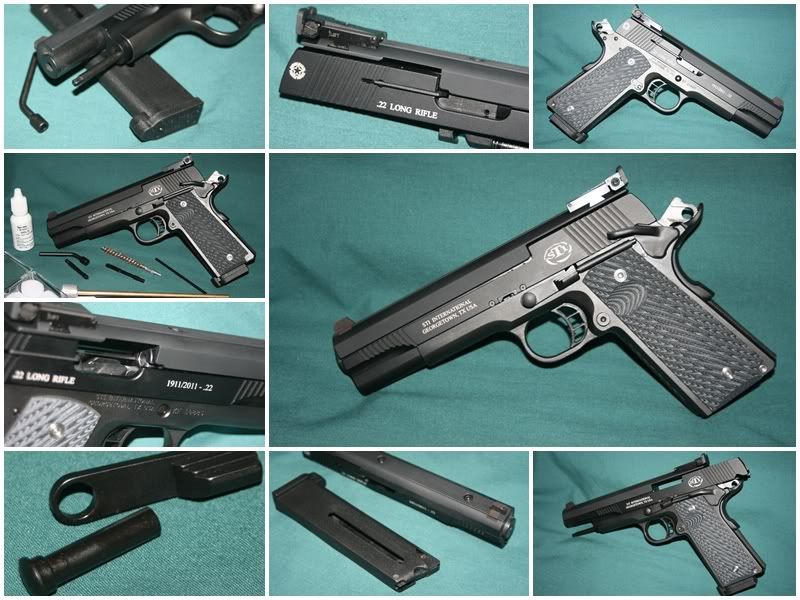
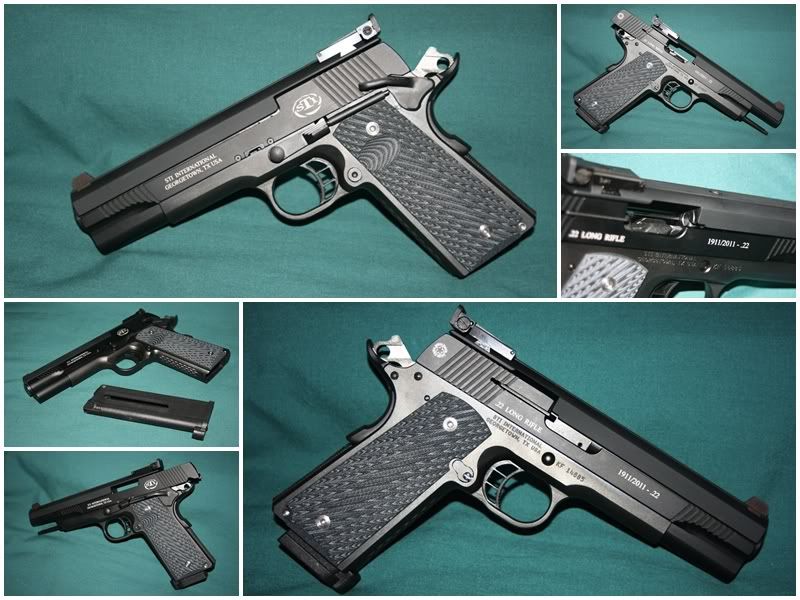
(manufactured for STI by Advantage Arms)
Feeling the pinch of high factory ammunition costs for .45ACP, but still want to get more practice or plinking time in with your 1911? One option is to buy a .22LR conversion kit. A variety of manufacturers, such as Advantage Arms, Ciener, and Kimber, sell these kits for 1911s. You can also get them for a variety of Glocks, Sig Sauers, etc. that are not 1911 designs.
I am a fan of STI 1911s and my local dealer, having sold four of them to me, knows this. When I asked about a 1911 conversion kit while picking up my second Ranger II about a year ago, he made me a good deal for the last STI branded kit he had in stock.
The STI kit has the STI logo, company name and location on the left side of the slide. It also has the "Robert Marvel, Custom Pistols" logo and a caliber notation on the right side of the slide. STI has discontinued sales of their rebranded kits, but you can still buy the equivalent from Advantage Arms.

The installation process is simple and is basically the same as removing and reassembling your current slide and frame. The only exception is that the guide rod is threaded, and turning it tightens the pin to the barrel.
1. Remove the slide from your 1911
2. Slide the conversion slide onto your government sized 1911 frame
3. Install the conversion kit slide stop
4. Retract the slide about 1/2" and tighten the guide rod using the supplied wrench and release the slide (the guide rod pushes against the slide stop to lock it against the barrel)
5. Function check the assembled pistol
The STI kit I bought is the target model, which has a two piece slide. The lower portion of the slide does the cycling. The upper portion of the slide doesn't move with the cycling, and it has the sights on top. The barrel is also fixed. Since neither the barrel nor the sights move while the action cycles, potential accuracy should be improved.
A quirk of this is that it's a little harder to do the slingshot method to chamber a round by using your whole hand over the top of the slide. Since the top doesn't move, you have to grab the rear cocking serrations with your finger and thumb and draw it back that way. This isn't a big deal for my purposes.
If you want to practice using it as a defensive pistol and have it operate more like your 1911, you could opt for a non-target model from AA. The non-target model slide is one piece, but also carries with it less potential accuracy.
Unlike a 1911, the conversion kit uses an external extractor. I have not had any issues with it. The left side of the slide has a steel insert to prevent the slide stop from damaging the aluminum slide when the slide locks back on an empty magazine. The top of the slide has lengthwise grooves running down it between the sights, which are set into dovetails. The rear sight has horizontal grooves to help reduce reflections.


As you may expect of a slide that isn't able to be factory fit to a matching frame, the back of the slide doesn't follow the exact contour of the back of the Ranger II frame I typically use with the kit. This is entirely aesthetic, though, and has no affect on functionality. The fit of slide to frame rails is good, and that's what affects function. No problems here.


Another slight oddity is that the slide stop lever seems to extend out fairly far compared to a standard 1911. This is because AA uses a two piece assembly, which has a pin that fits through a hole in the lever. When in place, it acts as a single unit, but once removed from the pistol it separates into two pieces again. You can see how far it extends in the picture above.
How does it perform? Very well. Using high velocity ammunition, as recommended by the manual, allows the slide to cycle and lock back on an empty magazine reliably. Standard velocity will fire, but it may not always have enough energy to fully cycle with the lower powered ammo.
I haven't performed any formal accuracy testing, but about 1" groups at 7-15 yards are the norm in my offhand firing. I haven't tested their 50 yard accuracy claims because my pistol range doesn't extend that far.
A couple more odds and ends per the manual - AA recommends that you chamber a round using the "slingshot" method of pulling the slide fully rearward and releasing it. Dry firing "can be done, but is not recommended."

[B]Specs:[/B]
Custom fitted foam/plastic carrying case
CNC machined 7075-T6 aluminum slide with steel breech insert
Heat treated 4140 steel .22LR barrel, recoil spring and slide stop
Fixed barrel and sights unaffected by slide movement
Last round lock open
Fits any milspec government sized 1911 frame
Adjustable target style sights
Anodized finish on aluminum parts (per Mil-A-8625 standard)
Black oxide finish on steel parts
Polymer 10 round* magazine (one included)
Cleaning kit with rod, brush, patches, and oil included
Guide rod tension wrench included
Manufacturer recommended ammunition - 40 grain,high velocity, non-hollow point
Remington Golden Bullets for plinking
CCI MiniMags or Federal Automatch for accuracy
Standard velocity may be used when using an optional reduced power recoil spring
Claimed accuracy - average group size at 50 yards is 1.6" with bulk ammo, 1.0" with match ammo such as Eley 10x when used with the reduced recoil spring.
MSRP: STI version discontinued, Advantage Arms target models are $350 for direct purchase, magazines are $25/each
*Note: as per the FAQ on the Advantage Arms website, higher capacity magazines are not available due to the manufacturer's location in California. CA apparently bans even the manufacture of "high capacity" magazines within the state.


Sunday, February 20, 2011
Kahr PM9 vs CW9
Kahr PM9 vs CW9
One of the more common questions I come across in people's search for a carry pistol is, "what's the difference between Kahr's PM series and CW series?" To help answer that question, I put together this comparison of the Kahr PM9 and CW9 9mm pistols.
First, the differences between the CW and PM series are common regardless of caliber, and were done in the interest of having the CW available at a lower price point than the PM.
1. Sights: CW has a pinned front sight, PM has a drift adjustable front sight (which is easier to swap for night sights)
2. Rifling: CW has convential cut rifling, PM has "match grade" polygonal rifling (both have Lothar Walther stainless barrels)
3. Slide: CW has fewer maching operations on the exterior and uses more angular edges, PM9 is more rounded
4. Slide stop lever: CW has a MIM lever, PM has machined lever
5. Rollmarking: CW has simple engraving of model and manufacturer, PM has actual rollmark
6. Magazine: CW includes one magazine, PM includes two
CW9
Length: 5.9"
Height: 4.5"
Thickness: 0.90"
Weight: 15.8 ounces w/o magazine (magazine weighs 1.9 ounces)
Barrel: 3.6" stainless steel with conventional rifling, 1:10" RH twist
Sights: drift adjustable white bar-dot combat rear sight, pinned polymer front sight
Capacity: 7+1 (single magazine included)
Ammunition: 9mm +P rated
PM9
Length: 5.3"
Height: 4.0"
Thickness: 0.90"
Weight: 14 ounces w/o magazine (magazine weighs 1.9 ounces)
Barrel: 3.0" stainless steel with polygonal rifling, 1:10" RH twist
Sights: drift adjustable white bar-dot combat sights, tritium optional
Capacity: 6+1 with flush floorplate, 7+1 with magazine extension (both magazines included)
Ammunition: 9mm +P rated
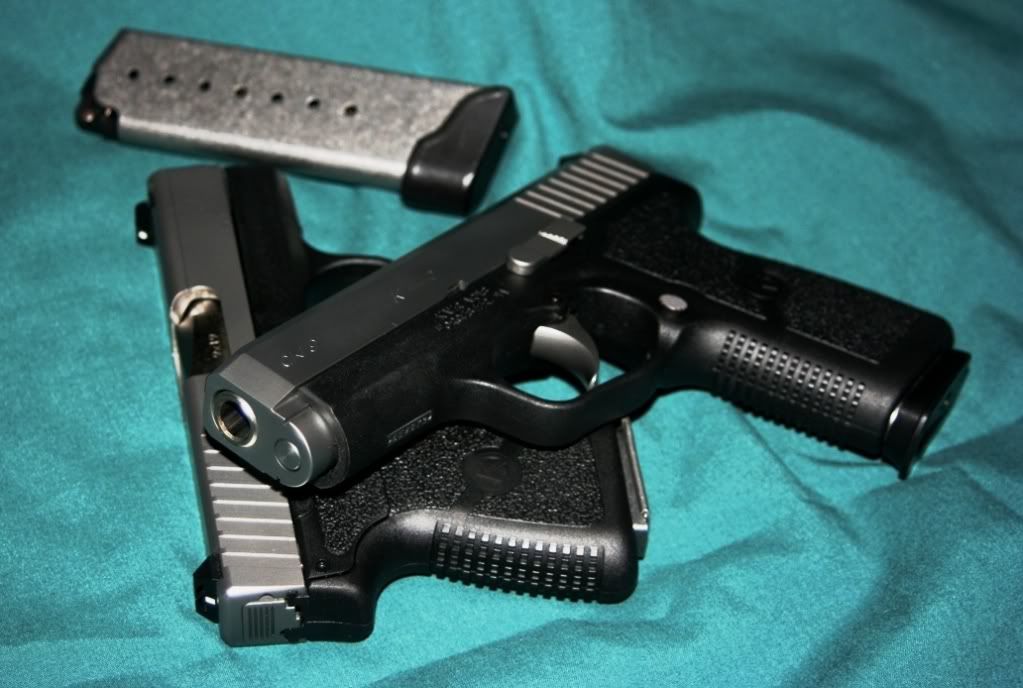
Other than the differences mentioned above, the CW9 and PM9 have much in common. The pistols are predominantly stainless steel and polymer. The CW line has a single MIM part discussed below. The PM line has no MIM parts.
Both pistols are striker fired with double action only triggers (no second strike capability). The barrel blanks are made at the Lothar walther factory where the high tensile strength steel billet is gun drilled and rifled. Kahr takes the blanks and completes the barrel machining at their own factory using CNC equipment.
The slide is made from 416 stainless steel on Kahr's CNC equipment and is heat treated and tempered for durability. The slide stop lever is machined from a different steel alloy for the PM, while the CW line gets a MIM lever.
Kahr magazines are also stainless steel, and after stamping are plasma welded for durability. The magazine follower has a steel slide stop pin to help with reliable slide lock after firing the last round. This is also supposed to prevent wear on the plastic follower.
The pistol is striker fired, and the striker is placed partially under tension when the slide is released. Kahr uses a DAO cocking cam trigger to unlock the passive safety, complete cocking, and release the firing pin. This trigger setup feels very comparable to a DA revolver trigger in that the pull is fairly long but very smooth. The trigger is also placed high in the pistol next to the offset barrel, which keeps the grip smaller and your hand close to the bore axis for less felt recoil.
Certain models are available with an external safety if you want one, but the long trigger pull combined with the passive drop safety make one unnecessary for my purposes.
Both pistols have good texturing on the grip, external extractors, and single column magazines. Another interesting aspect of the polymer frame is a small panel on the side of the grip that is an overpressure safety device. If a round is fired and generates too much pressure, the panel will allow some of that to escape in a more controlled fashion, possibly saving the pistol from damage and the user from injury.
Kahr recommends a 200 round "break-in" period, during which they say you may expect some possible malfunctions as the pistol wears in. After 200 rounds you shouldn't have any problems. In my experience, neither my CW9 nor my PM9 has had a single malfunction, either before or after the "break-in" period.
As for accuracy, the CW9 allows a more comfortable full hand grip and tends to be a little easier for me to shoot accurately. Rapid fire at 15 yards results in easy baseball size or smaller groups. The PM9 is slightly harder to hold since my little finger won't fit on the grip (without the extended magazine). That results in slightly larger groups during rapid fire, but during slow fire the PM9 is at least the equal of the CW9. All of that will be shooter dependent, as the pistols have shown to be more accurate than I can shoot them offhand and more than adequate for self defense. I don't test pistols from a rest, so I have no results to share there.
The white bar-dot sights are very quick to acquire, but they are a little harder (for me anyway) to shoot accurately than a target style sight. All that's fine, though, because these are meant as defensive pistols and excel in that role.
Neither the CW9 nor the PM9 is a handful to shoot in my opinion. I typically carry a compact .45ACP, so the 9mm pistols are noticeably more tame. Both are easier than most pocket .380ACP pistols despite the larger round because of their larger size and weight. If you can shoot a Ruger LCP or snub nose .38 special okay, you should be fine with either of these, too.
So which one should you buy?
It depends. For lowest cost, extended range sessions, and largest grip size, the CW9 wins. It is easily concealable in an inside the waistband (IWB) holster and very comfortable there with its thin it slide, but wouldn't work in most anybody's pocket. For greater refinement (polygonal rifling, no MIM, smoother exterior slide treatment), sight adjustability, or pocket carry, the PM9 wins. Weight isn't a big issue as they differ by just 1.8 ounces.
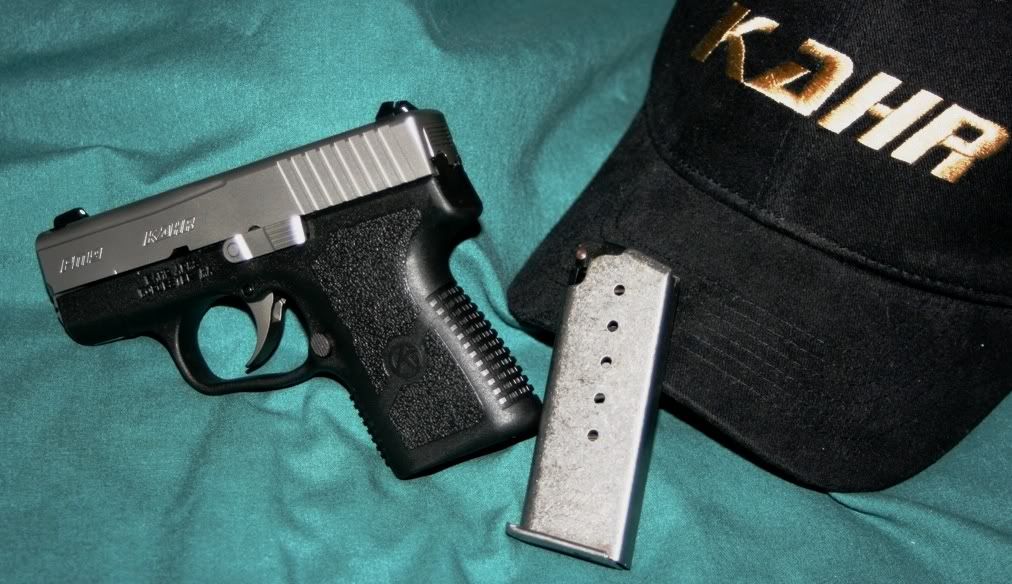
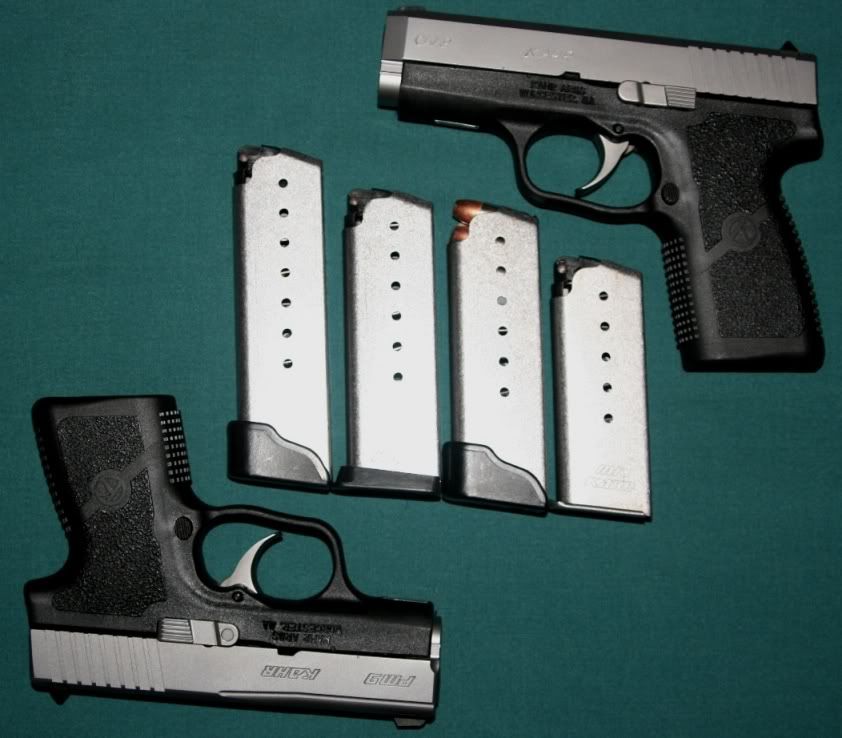
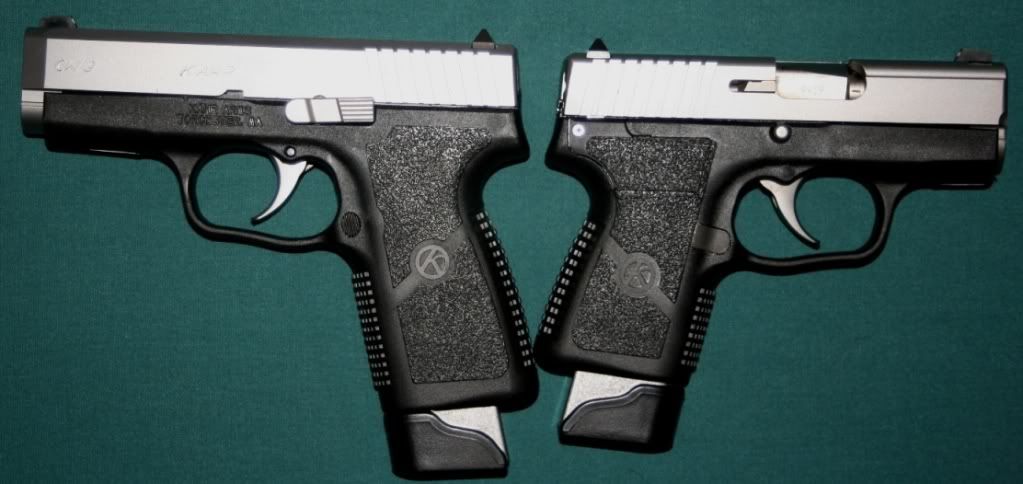



S&W Bodyguard 380 vs PM9

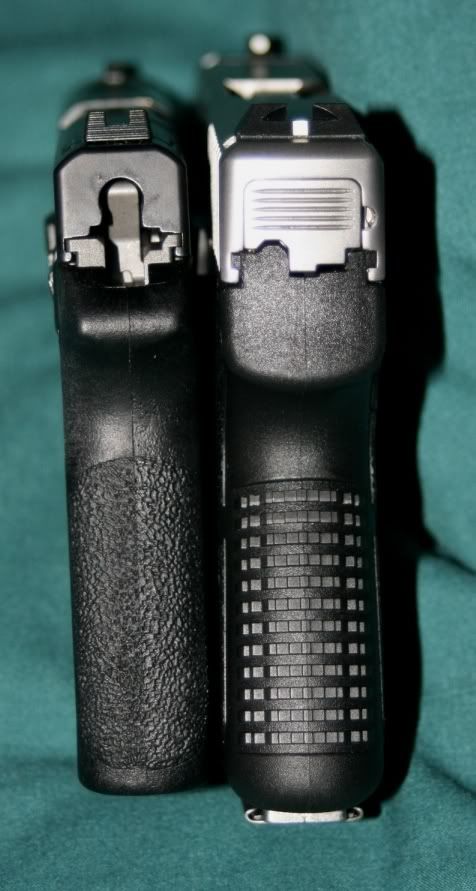
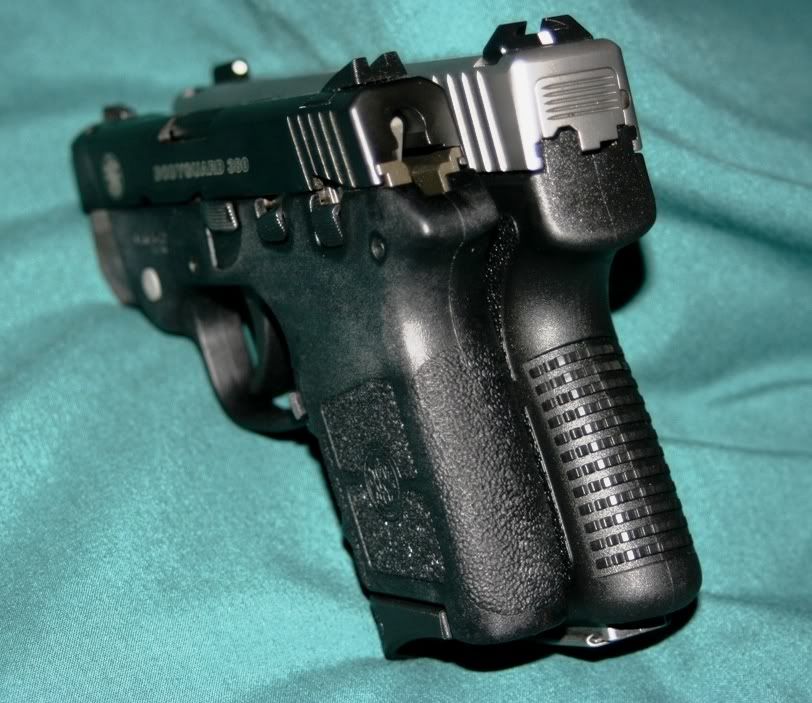
STI Shadow (Officer 1911) vs CW9
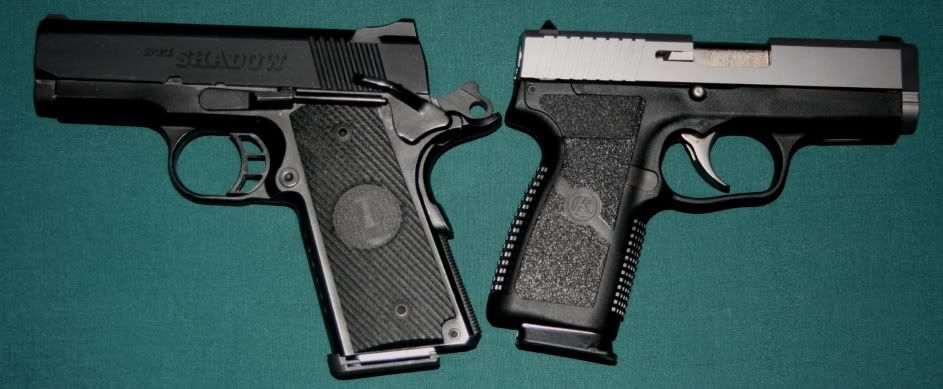

STI Ranger II (Commander 1911) vs CW9
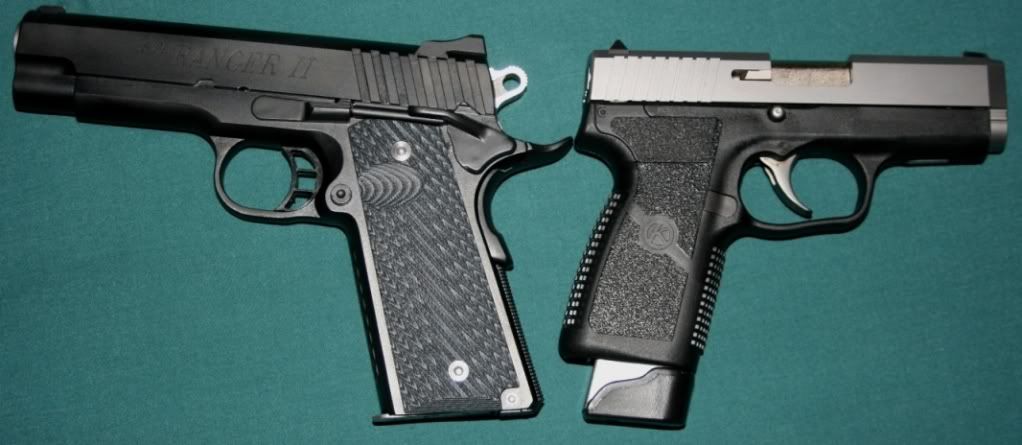

One of the more common questions I come across in people's search for a carry pistol is, "what's the difference between Kahr's PM series and CW series?" To help answer that question, I put together this comparison of the Kahr PM9 and CW9 9mm pistols.
First, the differences between the CW and PM series are common regardless of caliber, and were done in the interest of having the CW available at a lower price point than the PM.
1. Sights: CW has a pinned front sight, PM has a drift adjustable front sight (which is easier to swap for night sights)
2. Rifling: CW has convential cut rifling, PM has "match grade" polygonal rifling (both have Lothar Walther stainless barrels)
3. Slide: CW has fewer maching operations on the exterior and uses more angular edges, PM9 is more rounded
4. Slide stop lever: CW has a MIM lever, PM has machined lever
5. Rollmarking: CW has simple engraving of model and manufacturer, PM has actual rollmark
6. Magazine: CW includes one magazine, PM includes two
CW9
Length: 5.9"
Height: 4.5"
Thickness: 0.90"
Weight: 15.8 ounces w/o magazine (magazine weighs 1.9 ounces)
Barrel: 3.6" stainless steel with conventional rifling, 1:10" RH twist
Sights: drift adjustable white bar-dot combat rear sight, pinned polymer front sight
Capacity: 7+1 (single magazine included)
Ammunition: 9mm +P rated
PM9
Length: 5.3"
Height: 4.0"
Thickness: 0.90"
Weight: 14 ounces w/o magazine (magazine weighs 1.9 ounces)
Barrel: 3.0" stainless steel with polygonal rifling, 1:10" RH twist
Sights: drift adjustable white bar-dot combat sights, tritium optional
Capacity: 6+1 with flush floorplate, 7+1 with magazine extension (both magazines included)
Ammunition: 9mm +P rated

Other than the differences mentioned above, the CW9 and PM9 have much in common. The pistols are predominantly stainless steel and polymer. The CW line has a single MIM part discussed below. The PM line has no MIM parts.
Both pistols are striker fired with double action only triggers (no second strike capability). The barrel blanks are made at the Lothar walther factory where the high tensile strength steel billet is gun drilled and rifled. Kahr takes the blanks and completes the barrel machining at their own factory using CNC equipment.
The slide is made from 416 stainless steel on Kahr's CNC equipment and is heat treated and tempered for durability. The slide stop lever is machined from a different steel alloy for the PM, while the CW line gets a MIM lever.
Kahr magazines are also stainless steel, and after stamping are plasma welded for durability. The magazine follower has a steel slide stop pin to help with reliable slide lock after firing the last round. This is also supposed to prevent wear on the plastic follower.
The pistol is striker fired, and the striker is placed partially under tension when the slide is released. Kahr uses a DAO cocking cam trigger to unlock the passive safety, complete cocking, and release the firing pin. This trigger setup feels very comparable to a DA revolver trigger in that the pull is fairly long but very smooth. The trigger is also placed high in the pistol next to the offset barrel, which keeps the grip smaller and your hand close to the bore axis for less felt recoil.
Certain models are available with an external safety if you want one, but the long trigger pull combined with the passive drop safety make one unnecessary for my purposes.
Both pistols have good texturing on the grip, external extractors, and single column magazines. Another interesting aspect of the polymer frame is a small panel on the side of the grip that is an overpressure safety device. If a round is fired and generates too much pressure, the panel will allow some of that to escape in a more controlled fashion, possibly saving the pistol from damage and the user from injury.
Kahr recommends a 200 round "break-in" period, during which they say you may expect some possible malfunctions as the pistol wears in. After 200 rounds you shouldn't have any problems. In my experience, neither my CW9 nor my PM9 has had a single malfunction, either before or after the "break-in" period.
As for accuracy, the CW9 allows a more comfortable full hand grip and tends to be a little easier for me to shoot accurately. Rapid fire at 15 yards results in easy baseball size or smaller groups. The PM9 is slightly harder to hold since my little finger won't fit on the grip (without the extended magazine). That results in slightly larger groups during rapid fire, but during slow fire the PM9 is at least the equal of the CW9. All of that will be shooter dependent, as the pistols have shown to be more accurate than I can shoot them offhand and more than adequate for self defense. I don't test pistols from a rest, so I have no results to share there.
The white bar-dot sights are very quick to acquire, but they are a little harder (for me anyway) to shoot accurately than a target style sight. All that's fine, though, because these are meant as defensive pistols and excel in that role.
Neither the CW9 nor the PM9 is a handful to shoot in my opinion. I typically carry a compact .45ACP, so the 9mm pistols are noticeably more tame. Both are easier than most pocket .380ACP pistols despite the larger round because of their larger size and weight. If you can shoot a Ruger LCP or snub nose .38 special okay, you should be fine with either of these, too.
So which one should you buy?
It depends. For lowest cost, extended range sessions, and largest grip size, the CW9 wins. It is easily concealable in an inside the waistband (IWB) holster and very comfortable there with its thin it slide, but wouldn't work in most anybody's pocket. For greater refinement (polygonal rifling, no MIM, smoother exterior slide treatment), sight adjustability, or pocket carry, the PM9 wins. Weight isn't a big issue as they differ by just 1.8 ounces.






S&W Bodyguard 380 vs PM9



STI Shadow (Officer 1911) vs CW9


STI Ranger II (Commander 1911) vs CW9


A Texas Ranger
A Texas Ranger
The STI Ranger II is a single stack 1911 with a commander* length slide and a government sized frame. It is available in .45ACP as you'd expect, and also in .40 S&W and 9x19mm. I have one in .45ACP and another in 9x19mm, which I purchased for cheaper practice and to have one 1911 in 9mm.
The Ranger II frame is steel and made in house by STI in Georgetown, TX, along with the rest of the pistol. According to STI, the only parts they don't make in house are pins and springs. I guess that makes this pistol a "Texas Ranger."
The front strap has STI's "STIppling" treatment, which I really like. It resembles chain link and gives a solid grip without being overly rough. The frame has a high cut trigger guard to facilitate taking a higher grip on the pistol, which can help with recoil control and accuracy. The mainspring housing is a flat style checkered polymer. The grip safety is of the beavertail variety with knuckle relief, and the thumb safety is a single-sided extended lever.
The steel slide has a flat top cut, rear cocking serrations that are a bit wide visually but provide good grip, and a chamfered forend for easier holstering if you carry it (if I didn't like my Shadow so much, I would install night sights and carry this pistol every day).
The bull barrel is fully supported and ramped, which some feel can make for more reliable feeding. I've yet to have a feeding problem in either of my Ranger IIs. Since it uses a bull barrel, there is no barrel bushing. The slide has an oversized ejection port to further aid in reliable cycling.
Rather than a traditional guide rod and spring, STI uses their RecoilMaster system in this pistol. STI's website says the RecoilMaster can have 10x the life of a "normal" setup. In my experience this is likely to be true. I haven't reached 10K rounds yet, but my Shadow has over 2K on the original RecoilMaster and 3" 1911s are known to wear out springs faster than full sized models. The RecoilMaster is made up of a couple of springs captured on a guide rod. It does require a plastic collar tool for takedown (two were included with each of my STI pistols).
The Ranger II hammer is STI's take on the commander style. The standard sights are STI's front and low mount rear sights. These sights have small horizontal grooves cut into them to reduce glare or reflections that could otherwise make it difficult to get a good sight picture. Night sights are available as an option.
STI pistols generally come with nicely checkered cocobolo grips with an STI logo on them. While these are very nice factory grips, I swapped mine out for Larry Davidson's Horned Lizard grips. These are made of G10 and have even more bite to them. I happen to like the look, too.
The Ranger II is a very good shooter, and both of mine have fed both FMJ and JHP ammo from a variety of manufacturers without problems. I did not need a "break-in period" with any of my STI pistols, and as far as I know STI doesn't claim you should need one (unlike some manufacturers).
The Ranger II is at home on the range, and it's equally adept as a concealed carry pistol. Although it is steel and weighs 33 ounces, a good belt and holster such as Tucker Gunleather's "Texas Heritage" make it pretty easy to carry comfortably. The extra weight vs. a polymer or aluminum frame will dampen felt recoil and allow for faster follow up shots. Sometimes a full sized pistol will be long enough to poke the chair depending upon the person wearing it. The shorter slide on the Ranger II helps avoid any discomfort while seated.
If you're looking for a reliable, well fit, made in the United States, commander-sized 1911, you may want to get a Texas Ranger of your own.
*technically, the slide is 4.15" vs the traditional 4.25" Colt Commander and it has a bull barrel.
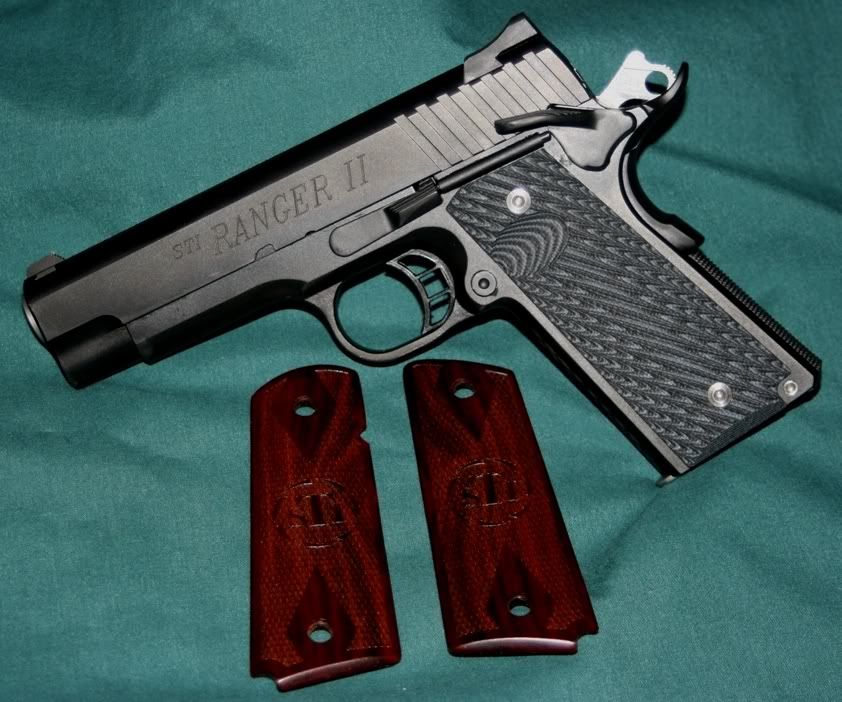

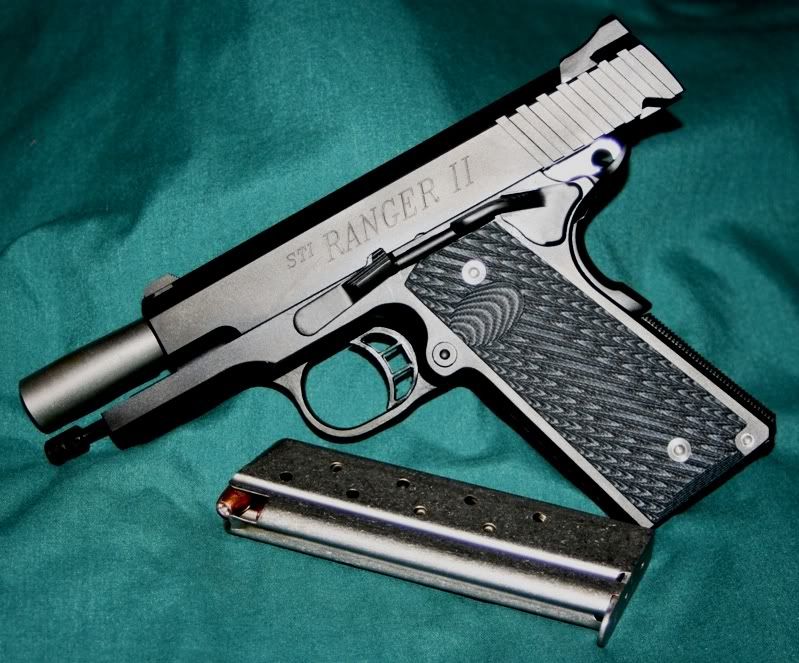
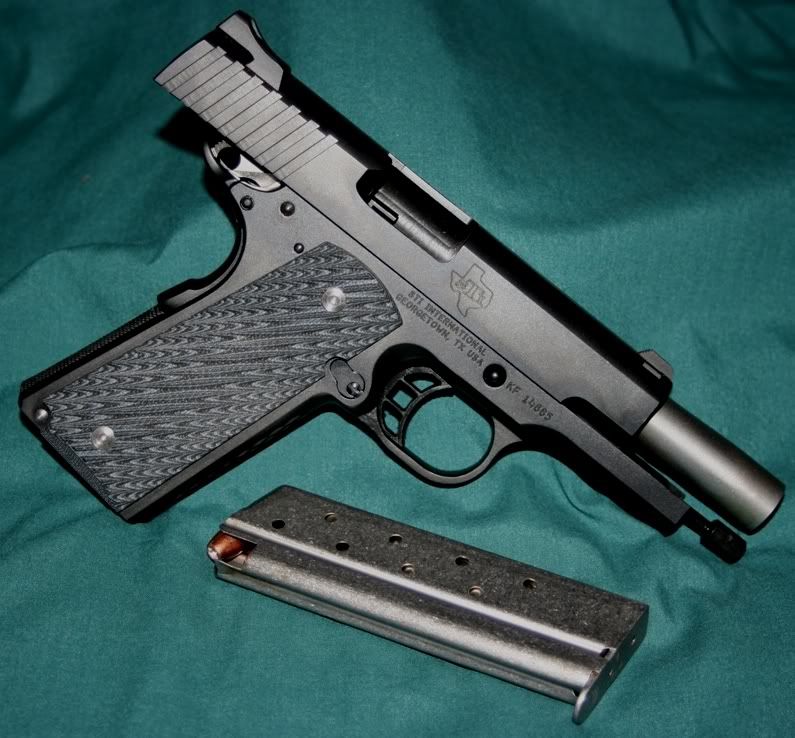
STI Ranger II
Caliber: .45ACP (.40S&W, 9x19mm optional)
Frame: full size steel frame
STIppled front strap
high rise trigger guard
oversized ejection port
Slide: steel commander length 4.15"
flat top
rear cocking serrations
chamfered forend
Barrel: 4.15" fully supported and ramped bull barrel
Mainspring Housing: flat checkered polymer
External Safety: single sided STI extended thumb safety
Grip Safety: knuckle relief beavertail
Sights: STI front and low mount rear
Guide rod: STI RecoilMaster system
Hammer: commander style
Other: STI long curved trigger with stainless bow
Thin cocobolo checkered grips
Finish: blued matte
Length: 7.75"
Weight: 33.0oz
Website: http://www.stiguns.com
MSRP: $1100
Options: Hard chrome $300
Tritium night sights $65
Single stack magwell with steel MSH $74
(prices above were current as of late 2010)
The STI Ranger II is a single stack 1911 with a commander* length slide and a government sized frame. It is available in .45ACP as you'd expect, and also in .40 S&W and 9x19mm. I have one in .45ACP and another in 9x19mm, which I purchased for cheaper practice and to have one 1911 in 9mm.
The Ranger II frame is steel and made in house by STI in Georgetown, TX, along with the rest of the pistol. According to STI, the only parts they don't make in house are pins and springs. I guess that makes this pistol a "Texas Ranger."
The front strap has STI's "STIppling" treatment, which I really like. It resembles chain link and gives a solid grip without being overly rough. The frame has a high cut trigger guard to facilitate taking a higher grip on the pistol, which can help with recoil control and accuracy. The mainspring housing is a flat style checkered polymer. The grip safety is of the beavertail variety with knuckle relief, and the thumb safety is a single-sided extended lever.
The steel slide has a flat top cut, rear cocking serrations that are a bit wide visually but provide good grip, and a chamfered forend for easier holstering if you carry it (if I didn't like my Shadow so much, I would install night sights and carry this pistol every day).
The bull barrel is fully supported and ramped, which some feel can make for more reliable feeding. I've yet to have a feeding problem in either of my Ranger IIs. Since it uses a bull barrel, there is no barrel bushing. The slide has an oversized ejection port to further aid in reliable cycling.
Rather than a traditional guide rod and spring, STI uses their RecoilMaster system in this pistol. STI's website says the RecoilMaster can have 10x the life of a "normal" setup. In my experience this is likely to be true. I haven't reached 10K rounds yet, but my Shadow has over 2K on the original RecoilMaster and 3" 1911s are known to wear out springs faster than full sized models. The RecoilMaster is made up of a couple of springs captured on a guide rod. It does require a plastic collar tool for takedown (two were included with each of my STI pistols).
The Ranger II hammer is STI's take on the commander style. The standard sights are STI's front and low mount rear sights. These sights have small horizontal grooves cut into them to reduce glare or reflections that could otherwise make it difficult to get a good sight picture. Night sights are available as an option.
STI pistols generally come with nicely checkered cocobolo grips with an STI logo on them. While these are very nice factory grips, I swapped mine out for Larry Davidson's Horned Lizard grips. These are made of G10 and have even more bite to them. I happen to like the look, too.
The Ranger II is a very good shooter, and both of mine have fed both FMJ and JHP ammo from a variety of manufacturers without problems. I did not need a "break-in period" with any of my STI pistols, and as far as I know STI doesn't claim you should need one (unlike some manufacturers).
The Ranger II is at home on the range, and it's equally adept as a concealed carry pistol. Although it is steel and weighs 33 ounces, a good belt and holster such as Tucker Gunleather's "Texas Heritage" make it pretty easy to carry comfortably. The extra weight vs. a polymer or aluminum frame will dampen felt recoil and allow for faster follow up shots. Sometimes a full sized pistol will be long enough to poke the chair depending upon the person wearing it. The shorter slide on the Ranger II helps avoid any discomfort while seated.
If you're looking for a reliable, well fit, made in the United States, commander-sized 1911, you may want to get a Texas Ranger of your own.
*technically, the slide is 4.15" vs the traditional 4.25" Colt Commander and it has a bull barrel.




STI Ranger II
Caliber: .45ACP (.40S&W, 9x19mm optional)
Frame: full size steel frame
STIppled front strap
high rise trigger guard
oversized ejection port
Slide: steel commander length 4.15"
flat top
rear cocking serrations
chamfered forend
Barrel: 4.15" fully supported and ramped bull barrel
Mainspring Housing: flat checkered polymer
External Safety: single sided STI extended thumb safety
Grip Safety: knuckle relief beavertail
Sights: STI front and low mount rear
Guide rod: STI RecoilMaster system
Hammer: commander style
Other: STI long curved trigger with stainless bow
Thin cocobolo checkered grips
Finish: blued matte
Length: 7.75"
Weight: 33.0oz
Website: http://www.stiguns.com
MSRP: $1100
Options: Hard chrome $300
Tritium night sights $65
Single stack magwell with steel MSH $74
(prices above were current as of late 2010)
How I Went Home with an Escort (a 1911 review)
How I Went Home with an Escort
No, no, no, not THAT kind of Escort. This was an STI Escort, an officer frame 1911.
If you've read my review of the STI Shadow, then you know how much I love that pistol and that I carry it daily. Now you may be wondering, if I love that Shadow so much, why did I buy an Escort? Well, I hadn't bought another pistol for a while, and I started getting that feeling. You might know the one. The one where you start thinking, I just NEED to add another gun to my collection. I had the itch. Had it bad.
I finally gave in and decided that I needed a backup 1911 from STI in the same size. Since I didn't want to limit myself to an identical pistol, I looked at other officer models and came away impressed with the STI Escort. Now, I have heard that there are wives out there who will buy firearms for their husbands. Birthdays, Christmas, whatever the occasion, but they buy them as gifts. Personally, I think they're a myth. It can't be true, can it? MY wife's never done that, and I'm awesome, so if anyone's wife would buy one, surely MINE would, right? Right?
Well, while I was waiting for hell to freeze over, I decided I'd better buy my own birthday present. Let's look up an Escort I said to myself! No, no, no, not that kind of Escort. Sheeesh, we've been through that already! My local dealer was out of Escorts,
and my birthday was just a few days away. Hmmm, maybe I'll check out Gunbroker just in case. It must have been my lucky day, because an auction was just ending on a NIB Escort from an out of state dealer, so I snagged it for $800. $355 off list, not bad I thought. Add in shipping and transfer fees and I was out the door two days before my birthday with my brand new .45ACP Escort for $850. Happy Biiiiirthday, G27, Happy Biiiiirthday to me.
The Escort is an officer length 1911 with a forged aluminum frame coated in KG and a blued carbon steel slide. Many of the features are just like the Shadow.... stippled front strap, checkered MSH, undercut trigger guard, machine beveled magwell, round top, 3" ramped bull barrel, RecoilMaster guide rod system, etc.
The main difference, aside from the finish, is the sights. The Shadow has Heinie Straight 8 tritium night sights recessed into a channel in the slide top. This pistol has a plain round top with TAS sights (Tactical Adjustable Sights) without illumination. The Escort also comes with standard width checkered cocobolo grips instead of the agressively textured G10 grips on the Shadow.
I decided that a birthday pistol needs some custom grips. So, a few emails back and forth with Esmeralda and I had a set of grips on order to my specifications. I combined the features I liked from several of her more common grips and asked her to blend them and some personalized incsriptions into the set you see below.
Alright, now down to the shooting. How did this pistol perform? In a word, great. Just like the Shadow I had no probems with any of my standard FMJ practice ammo (WWB or PMC) or with any of the JHP I tried (Speer, Hornady, Winchester, mostly). The factory mags and the thin baseplate Wilsons I favor both performed as expected. I lost track of round count on this one, but it's still low at somewhere between 600-800.
It is a little easier for me to be more precise with the Escort due to the different sights (3-dot Novak style rather than the Straight 8 "dot the i" night sights on the Shadow). On the other hand, I find the Heinie sights to be quicker to pick up, especially so in lower lighting with their tritium vials.
The RecoilMaster does seem to soften felt recoil, and translates that recoil into even more of a "push" back into the palm than most officer models. For comparison to a more typical guide rod and spring, my Colt Defender has a bit more muzzle rise. There are a lot of people who say an officer size 1911 won't be reliable. Both the Shadow and Escort have been very reliable for me. STI seems to have small 1911s figured out. Maybe the RecoilMaster is part of the answer.
As another benefit, the RecoilMaster is said by STI to last 10x the number of rounds before needing to be changed. I haven't reached a spring change interval with my Escort, but the Shadow would more than likely have required at least one by now and is still going strong.
Would I change anything about this pistol? For range use, no. For carry use, I would have preferred night sights but it's not a big enough deal to get me to swap them out. otherwise, it's another very nice 1911 that doesn't break the bank.
Hope this was informative and a little entertaining. Thanks for reading, and please enjoy some pictures.







STI Escort
Calibers: .45ACP (9x19mm optional)
Frame: forged aluminum
officer length
STIppled front strap
undercut trigger guard
machine beveled magwell
Slide: carbon steel
round top style
rear cocking serrations
oversized ejection port
Barrel: 3" fully supported and ramped bull barrel
Mainspring Housing: flat checkered polymer
External Safety: single sided STI extended thumb safety
Grip Safety: high rise beavertail
Sights: Tactical Adjustable Sight (TAS) - "Novak" style white 3-dot
Guide rod: STI RecoilMaster system
Hammer: commander style
Other: STI long curved trigger with stainless bow (~ 4.5 lbs weight)
STI logo checkered cocobolo grips, standard thickness
Finish: KG coated frame, blued slide
Length: 7.0"
Weight: 22.8oz
Website: http://www.stiguns.com
MSRP: $1155
No, no, no, not THAT kind of Escort. This was an STI Escort, an officer frame 1911.
If you've read my review of the STI Shadow, then you know how much I love that pistol and that I carry it daily. Now you may be wondering, if I love that Shadow so much, why did I buy an Escort? Well, I hadn't bought another pistol for a while, and I started getting that feeling. You might know the one. The one where you start thinking, I just NEED to add another gun to my collection. I had the itch. Had it bad.
I finally gave in and decided that I needed a backup 1911 from STI in the same size. Since I didn't want to limit myself to an identical pistol, I looked at other officer models and came away impressed with the STI Escort. Now, I have heard that there are wives out there who will buy firearms for their husbands. Birthdays, Christmas, whatever the occasion, but they buy them as gifts. Personally, I think they're a myth. It can't be true, can it? MY wife's never done that, and I'm awesome, so if anyone's wife would buy one, surely MINE would, right? Right?
Well, while I was waiting for hell to freeze over, I decided I'd better buy my own birthday present. Let's look up an Escort I said to myself! No, no, no, not that kind of Escort. Sheeesh, we've been through that already! My local dealer was out of Escorts,
and my birthday was just a few days away. Hmmm, maybe I'll check out Gunbroker just in case. It must have been my lucky day, because an auction was just ending on a NIB Escort from an out of state dealer, so I snagged it for $800. $355 off list, not bad I thought. Add in shipping and transfer fees and I was out the door two days before my birthday with my brand new .45ACP Escort for $850. Happy Biiiiirthday, G27, Happy Biiiiirthday to me.
The Escort is an officer length 1911 with a forged aluminum frame coated in KG and a blued carbon steel slide. Many of the features are just like the Shadow.... stippled front strap, checkered MSH, undercut trigger guard, machine beveled magwell, round top, 3" ramped bull barrel, RecoilMaster guide rod system, etc.
The main difference, aside from the finish, is the sights. The Shadow has Heinie Straight 8 tritium night sights recessed into a channel in the slide top. This pistol has a plain round top with TAS sights (Tactical Adjustable Sights) without illumination. The Escort also comes with standard width checkered cocobolo grips instead of the agressively textured G10 grips on the Shadow.
I decided that a birthday pistol needs some custom grips. So, a few emails back and forth with Esmeralda and I had a set of grips on order to my specifications. I combined the features I liked from several of her more common grips and asked her to blend them and some personalized incsriptions into the set you see below.
Alright, now down to the shooting. How did this pistol perform? In a word, great. Just like the Shadow I had no probems with any of my standard FMJ practice ammo (WWB or PMC) or with any of the JHP I tried (Speer, Hornady, Winchester, mostly). The factory mags and the thin baseplate Wilsons I favor both performed as expected. I lost track of round count on this one, but it's still low at somewhere between 600-800.
It is a little easier for me to be more precise with the Escort due to the different sights (3-dot Novak style rather than the Straight 8 "dot the i" night sights on the Shadow). On the other hand, I find the Heinie sights to be quicker to pick up, especially so in lower lighting with their tritium vials.
The RecoilMaster does seem to soften felt recoil, and translates that recoil into even more of a "push" back into the palm than most officer models. For comparison to a more typical guide rod and spring, my Colt Defender has a bit more muzzle rise. There are a lot of people who say an officer size 1911 won't be reliable. Both the Shadow and Escort have been very reliable for me. STI seems to have small 1911s figured out. Maybe the RecoilMaster is part of the answer.
As another benefit, the RecoilMaster is said by STI to last 10x the number of rounds before needing to be changed. I haven't reached a spring change interval with my Escort, but the Shadow would more than likely have required at least one by now and is still going strong.
Would I change anything about this pistol? For range use, no. For carry use, I would have preferred night sights but it's not a big enough deal to get me to swap them out. otherwise, it's another very nice 1911 that doesn't break the bank.
Hope this was informative and a little entertaining. Thanks for reading, and please enjoy some pictures.







STI Escort
Calibers: .45ACP (9x19mm optional)
Frame: forged aluminum
officer length
STIppled front strap
undercut trigger guard
machine beveled magwell
Slide: carbon steel
round top style
rear cocking serrations
oversized ejection port
Barrel: 3" fully supported and ramped bull barrel
Mainspring Housing: flat checkered polymer
External Safety: single sided STI extended thumb safety
Grip Safety: high rise beavertail
Sights: Tactical Adjustable Sight (TAS) - "Novak" style white 3-dot
Guide rod: STI RecoilMaster system
Hammer: commander style
Other: STI long curved trigger with stainless bow (~ 4.5 lbs weight)
STI logo checkered cocobolo grips, standard thickness
Finish: KG coated frame, blued slide
Length: 7.0"
Weight: 22.8oz
Website: http://www.stiguns.com
MSRP: $1155
The Tale of the Shadow (a 1911 review)
This is a tale about my absolute favorite concealed carry pistol. I first came across the STI Shadow in a local gun shop. I saw it sitting there in the case next to the other 1911s, but this one looked different, subtle even, and didn't really jump out at me at first. After a while though, the Shadow really caught my eye. It looked dark, shadowy even, with its matte black KG coating and the "STI Shadow" rollmark upon the slide. I flipped it over, and there, on the other side of the slide, was the outline of the great state of Texas. Not just made in the USA, made in Texas. What red-blooded Texan can resist that little touch?
Easy now, I said to myself, check it over really well before you do anything. You already have a Colt Defender. Do you really need a second officer model 1911? Of course you do shouted the voice over my shoulder!!! The Colt is great, it's reliable, I said. But it's shiny and stands out! It doesn't have night sights! It doesn't have a checkered front strap! Without the Hogue wraparound grips, it's a bit slippery! Grip tape is ugly, and, well, you just don't carry the Colt like you thought you would, said the voice over my shoulder. Easy now, I said to myself again.
Sufficiently calmed down and more objective now, I proceeded to give the Shadow a good inspection. After handling the Shadow in the store for a while, I knew it was the pistol I had to have for CCW. It fit my hand extremely well, and the G10 mycarta grips, stippled front strap, and checkered MSH provided a very sure grip without discomfort. The Heinie two dot tritium night sights, recessed into a grooved sight channel on the top of the slide, sealed the deal. Full size sights in a snag-free setup? Perfect. BUY IT!!! screamed the voice. Now convinced, I laid down the cash and was on my way.
My Shadow, chambered in .45ACP, came home with me that day and got a good cleaning. Knowing the perhaps overblown reputation small 1911s have for unreliability, I immediately ran 250 rounds of 230 grain FMJ PMC through it at the range the next day. Zero malfunctions. This was looking good, I thought. Next, I ran 100 rounds of Winchester 230 grain JHP through it. Zero malfunctions. Oh boy, this was looking REALLY good.
After going through 350 rounds that day, I took it home and gave it a good cleaning. I went back to the range several more times over a couple weeks, and after 750 rounds of various 230 grain FMJ and 250 rounds of various 230 grain JHP, including my chosen carry ammo, this pistol became my new daily carry.
Since that time, my Shadow goes with me everywhere it can. It usually travels in a Tucker Gunleather "Cover Up" IWB holster. I ordered mine from Tucker rough side out to assist the single kydex belt clip with keeping it in place. It's a great pair. Easy to put on, and easy to take off if necessary. Reholstering is a snap.
The Shadow has a bit of wear now, mostly holster wear and some wear on the front strap from carrying and shooting it as much as possible. I have yet to have a malfunction with either the factory magazine or the black low profile Wilson magazines I bought to carry with it. I did have a few malfunctions using the magazine that came with my Colt Defender, but those were clearly attributed to that magazine and I no longer use it with the Shadow.
How's the accuracy, you may be wondering? The two dot Straight 8 style sights are very quick to acquire, and though they may give up a bit of accuracy to a more target oriented sight, it is by a very slim margin. I don't particularly shoot for group size with handguns, and I never shoot them from a rest, but here's my take on the Shadow. Fifty round rapid fire groups offhand at 7 yards make one baseball sized hole. At 25 yards slow fire, I can keep things to a golfball if I'm not having a bad day. It's a very accurate pistol.
In the realm of CCW officer model 1911s, I highly recommend this pistol if you're looking for one in the +/- $1200 range. More expensive than the Colt Defender? Sure, but you get night sights, extended safety, stippled front strap, etc. for just $300 or so more. Hope you enjoyed the review and thanks for looking.
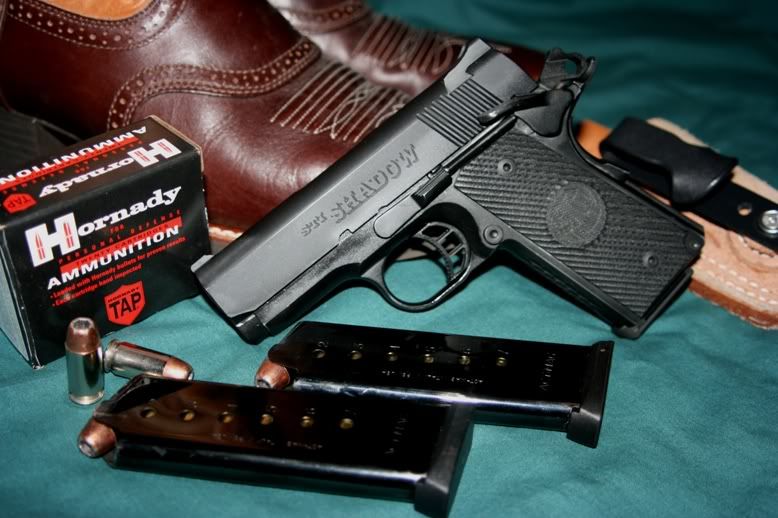
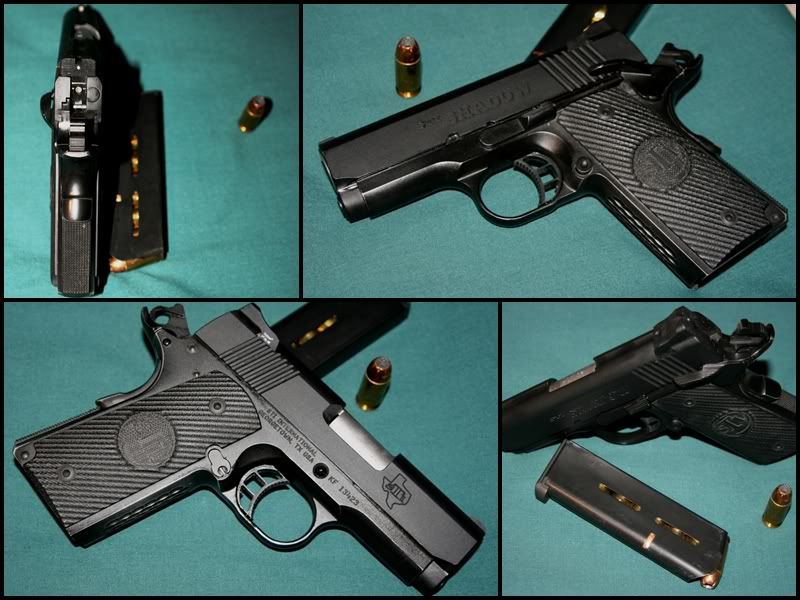
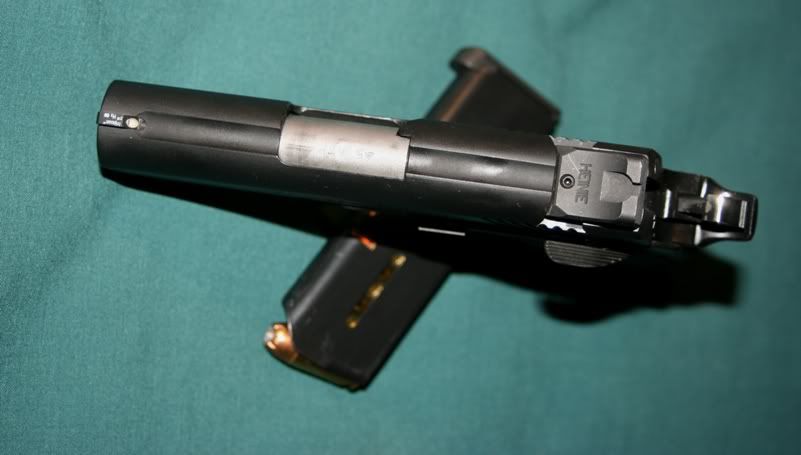
STI Shadow Specifications
Calibers: .45ACP (.40S&W, 9x19mm optional)
Frame: forged aluminum officer length
STIppled front strap
undercut trigger guard
oversized ejection port
Slide: carbon steel round top
integral sight channel
rear cocking serrations
Barrel: 3" fully supported and ramped bull barrel
Mainspring Housing: flat checkered polymer
External Safety: single sided STI extended thumb safety
Grip Safety: bobbed high rise knuckle relief beavertail
Sights: 2 dot tritium night sights
recessed into the slide
(Heinie Straight 8)
Guide rod: STI RecoilMaster system
Hammer: commander style
Other: Beveled Magwell
STI long curved trigger with stainless bow
G10 mycarta grips
Finish: KG black
Length: 7.0"
Weight: 22.8oz
Website: http://www.stiguns.com
MSRP: $1370
Easy now, I said to myself, check it over really well before you do anything. You already have a Colt Defender. Do you really need a second officer model 1911? Of course you do shouted the voice over my shoulder!!! The Colt is great, it's reliable, I said. But it's shiny and stands out! It doesn't have night sights! It doesn't have a checkered front strap! Without the Hogue wraparound grips, it's a bit slippery! Grip tape is ugly, and, well, you just don't carry the Colt like you thought you would, said the voice over my shoulder. Easy now, I said to myself again.
Sufficiently calmed down and more objective now, I proceeded to give the Shadow a good inspection. After handling the Shadow in the store for a while, I knew it was the pistol I had to have for CCW. It fit my hand extremely well, and the G10 mycarta grips, stippled front strap, and checkered MSH provided a very sure grip without discomfort. The Heinie two dot tritium night sights, recessed into a grooved sight channel on the top of the slide, sealed the deal. Full size sights in a snag-free setup? Perfect. BUY IT!!! screamed the voice. Now convinced, I laid down the cash and was on my way.
My Shadow, chambered in .45ACP, came home with me that day and got a good cleaning. Knowing the perhaps overblown reputation small 1911s have for unreliability, I immediately ran 250 rounds of 230 grain FMJ PMC through it at the range the next day. Zero malfunctions. This was looking good, I thought. Next, I ran 100 rounds of Winchester 230 grain JHP through it. Zero malfunctions. Oh boy, this was looking REALLY good.
After going through 350 rounds that day, I took it home and gave it a good cleaning. I went back to the range several more times over a couple weeks, and after 750 rounds of various 230 grain FMJ and 250 rounds of various 230 grain JHP, including my chosen carry ammo, this pistol became my new daily carry.
Since that time, my Shadow goes with me everywhere it can. It usually travels in a Tucker Gunleather "Cover Up" IWB holster. I ordered mine from Tucker rough side out to assist the single kydex belt clip with keeping it in place. It's a great pair. Easy to put on, and easy to take off if necessary. Reholstering is a snap.
The Shadow has a bit of wear now, mostly holster wear and some wear on the front strap from carrying and shooting it as much as possible. I have yet to have a malfunction with either the factory magazine or the black low profile Wilson magazines I bought to carry with it. I did have a few malfunctions using the magazine that came with my Colt Defender, but those were clearly attributed to that magazine and I no longer use it with the Shadow.
How's the accuracy, you may be wondering? The two dot Straight 8 style sights are very quick to acquire, and though they may give up a bit of accuracy to a more target oriented sight, it is by a very slim margin. I don't particularly shoot for group size with handguns, and I never shoot them from a rest, but here's my take on the Shadow. Fifty round rapid fire groups offhand at 7 yards make one baseball sized hole. At 25 yards slow fire, I can keep things to a golfball if I'm not having a bad day. It's a very accurate pistol.
In the realm of CCW officer model 1911s, I highly recommend this pistol if you're looking for one in the +/- $1200 range. More expensive than the Colt Defender? Sure, but you get night sights, extended safety, stippled front strap, etc. for just $300 or so more. Hope you enjoyed the review and thanks for looking.



STI Shadow Specifications
Calibers: .45ACP (.40S&W, 9x19mm optional)
Frame: forged aluminum officer length
STIppled front strap
undercut trigger guard
oversized ejection port
Slide: carbon steel round top
integral sight channel
rear cocking serrations
Barrel: 3" fully supported and ramped bull barrel
Mainspring Housing: flat checkered polymer
External Safety: single sided STI extended thumb safety
Grip Safety: bobbed high rise knuckle relief beavertail
Sights: 2 dot tritium night sights
recessed into the slide
(Heinie Straight 8)
Guide rod: STI RecoilMaster system
Hammer: commander style
Other: Beveled Magwell
STI long curved trigger with stainless bow
G10 mycarta grips
Finish: KG black
Length: 7.0"
Weight: 22.8oz
Website: http://www.stiguns.com
MSRP: $1370
Subscribe to:
Posts (Atom)